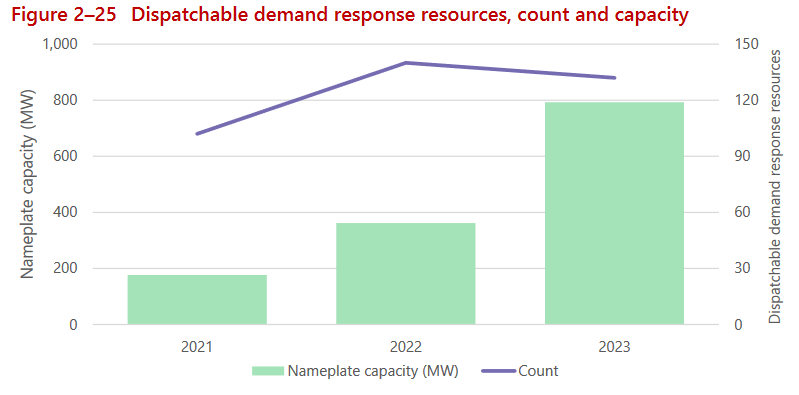The Case for Aggregator-Based Demand Response in Resource Adequacy Credits at SPP
Aggregator-based demand response programs must qualify for resource adequacy credits. Demand response must be on the level playing field as a generator.
“It is the policy of the United States that . . . unnecessary barriers to demand response participation in energy, capacity, and ancillary service markets shall be eliminated.”
Source - Footnote 21, referring to 2005 Energy Policy Act, https://www.ferc.gov/sites/default/files/2020-06/Order-745.pdf
But, yet, we have barriers to demand response participation in resource adequacy capacity.
The energy landscape is evolving rapidly, driven by the twin imperatives of sustainability and reliability. As we navigate this transition, demand response (DR) programs emerge as a crucial tool, enabling us to manage energy consumption more intelligently and efficiently. However, for DR programs to realize their full potential, we must broaden our approach to resource adequacy credits.
Specifically, aggregator-based demand response programs must qualify for these credits.
This shift is not just a technical adjustment but a necessary evolution to ensure a resilient and equitable energy future.
Source - SPP Market Monitor Report
SPP’s peak demand is 56,184 MW record was set in August 2023. But SPP has 800 MW of dispatchable demand response, which is only 1% of peak demand. MISO has 10% of peak demand as demand response. That’s the concern with SPP’s demand response programs.
This blog is based on Voltus’s presentation to the May 29, 2024, Supply Adequacy Working Group at the Southwest Power Pool (SPP).
Unlocking Untapped Potential
Aggregator-based demand response programs, which pool the efforts of multiple small-scale consumers to act as a single, large-scale resource, represent an untapped reservoir of capacity. These programs harness the flexibility of thousands of individual participants, turning them into a formidable force that can be dispatched to balance the grid. By allowing these aggregators to qualify for resource adequacy credits, we can unlock this potential and provide a significant boost to grid reliability.
Source - SPP Market Monitor report
Take, for example, Voltus, a leader in the demand response space. Since entering the Southwest Power Pool (SPP) market, Voltus has demonstrated the power of aggregated DR, contributing hundreds of megawatts to spinning reserves and the energy market. Their average dispatch performance in 2023 was a stellar 94%, with 70% of megawatts dispatched through automation. These figures highlight the reliability and effectiveness of aggregator-based DR programs, making a compelling case for their inclusion in resource adequacy frameworks.
“As of December 31, 2023, there were 132 demand response resources in the SPP market, representing 793 MW of nameplate capacity.” SPP Market Monitor
Ensuring Equity and Fairness
Excluding aggregator-based DR from resource adequacy credits creates an uneven playing field, favoring larger, traditional utilities over innovative, flexible solutions. In other major markets such as MISO, NYISO, CAISO, ISO-NE, PJM, and ERCOT, aggregator-based DR is already recognized and rewarded for its capacity contributions. Aligning the SPP with these markets would not only ensure fairness but also encourage a more competitive and diverse energy sector.
Source - FERC 2023 Assessment of Demand Response and Advanced Metering.
This move would also democratize energy participation, allowing smaller consumers to play a direct role in grid management and benefit financially from their participation. It supports a decentralized energy model where consumers are not just passive users but active participants in the energy ecosystem.
Enhancing Grid Resilience
The energy grid is under increasing strain from rising demand, aging infrastructure, and the growing prevalence of renewable energy sources. Aggregator-based DR programs provide a flexible, scalable solution to these challenges. By dispatching aggregated demand response resources, grid operators can quickly and effectively balance supply and demand, particularly during peak periods or unexpected disruptions.
Voltus’s experience in the SPP market illustrates how aggregator-based DR can contribute significantly to grid stability. Their resources have proven their ability to maintain the reliability of the SPP Balancing Authority, demonstrating that aggregators can meet, if not exceed, the performance standards of traditional resources.
A lot of ISOs are penalizing demand response, as discussed earlier.
Fostering Innovation and Sustainability
Including aggregator-based DR in resource adequacy credits also fosters innovation and supports the transition to a more sustainable energy system. Aggregators like Voltus specialize in deploying advanced technologies and data-driven strategies to optimize energy usage. Their participation pushes the entire industry towards smarter, more efficient energy solutions, accelerating the adoption of renewable energy sources and reducing reliance on fossil fuels.
MISO plans to rely on Load Modifying Resources this summer.
Source - MISO 2024 Summer Assessment
Conclusion
The case for including aggregator-based demand response programs in resource adequacy credits is clear and compelling. It unlocks substantial capacity potential, ensures equity, enhances grid resilience, and drives innovation. As we look to the future, our energy policies must reflect the realities of a modern, dynamic grid. By embracing aggregator-based DR, we can build a more reliable, equitable, and sustainable energy system for all.
It’s time for policymakers and stakeholders in the SPP and beyond to recognize the vital role of aggregator-based demand response and grant it the resource adequacy credits it deserves. The future of our energy grid depends on it.






